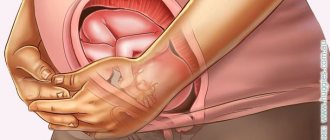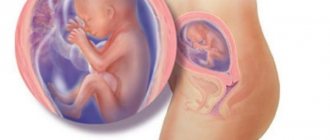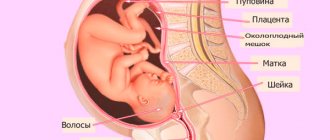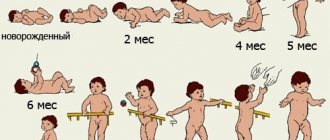The baby's first movements... How much joy they bring to the expectant mother! In addition to joy and pleasant excitement, they also serve as an indicator of the normal development of the fetus. As a rule, a woman who is carrying more than her first child looks forward to this event even more, because she knows what to expect. And he may even begin to worry if the future baby is in no hurry to make himself known.
As you know, the first movements of the child during the second pregnancy are observed a little earlier than during the first. But still, when can we expect them? Let's look at it below.
This happens for a variety of reasons.
1. The psychological state of all women is different not only in general, but also at a certain moment.
2. The characteristics of her nervous system are different each time.
3. The build of pregnant women is also different (it is believed that thin women feel fetal movements much earlier than plump women).
4. The amount of water for each expectant mother is different (the more there are, the more spacious the baby will be).
And many women expecting a child claim that it is not only the timing of the beginning of the baby’s motor activity that makes their “interesting” position the second time different. Often with sensations.
Motor activity of the baby, what is it?
It is with the first movement and the first push of the fetus that the woman begins to perceive her pregnancy. Now she clearly begins to feel this small living creature that is kicking and pushing her. But all this is so pleasant for her, at these moments she experiences happiness and a bunch of pleasant things.
On average, at about 16-20 weeks, the first movement occurs, or rather, the movement is far from the first, but the woman begins to feel them, and therefore such movements are usually called the first movements of the fetus. They can be felt both earlier and at a later date. All this is usually purely individual for each lady.
Reasons why different periods of movement occur
- Women have different psychological moods, which change throughout the entire period.
- Differences in the area of the nervous system.
- Each pregnant woman’s condition is always individual (and according to statistics, it is thin women who feel the fetal movement first).
- Each woman has a different amount of water accumulation, which also affects the process of movement.
And according to most women, the sensations of the baby’s movement are completely different at the time of the mother’s second pregnancy.
We also recommend reading: Brown discharge during pregnancy
First fetal movement. Second pregnancy
In fact, the fetus inside the uterus begins to actively manifest itself much earlier, after about 49-56 days from the beginning of pregnancy, and at 10 weeks it can already change the trajectory of its movements and even move from one part of the abdomen to another. Only the fetus is still very small and rarely touches the walls so that these movements can be felt. He “floats” in the amniotic fluid, without particularly bothering the mother.
From the 16th week the reaction to sound begins, from the 17th the eyes close and open (the child squints). But with the 18th, he pulls the umbilical cord with his hands, moves his fingers (opens and squeezes them), touches his face. From this “age” his movement is felt quite strongly.
Doctors believe that the fetus begins to move as soon as certain parts of the brain “turn on” to work. The child seems to be showing that a phase of his mental activity has begun.
At first, the movements of the fetus are barely felt, chaotic, somewhat reminiscent of the chaotic movement of many fish in an aquarium or some kind of bubbles. Therefore, an inexperienced mother does not distinguish between these tremors.
At what age does a baby start to move? First pregnancy: fetal movement
The time when a woman carries a child in her womb is one of the happiest and most enjoyable moments. However, with the onset of pregnancy, the expectant mother has many questions with which she turns to her friends or the local gynecologist. This article will talk about how a baby moves in the stomach. You will learn all the intricacies of this process. You can also find out at what weeks the baby begins to move during the first pregnancy.
Reasons for differences in women's feelings
After 140 days of development, movements are more active: the baby can change its position and move to different parts of the mother’s abdomen.
During the first pregnancy, women usually feel their baby for the first time at about 18-20 weeks, when the “pushing” can no longer be confused with anything. But during repeated periods this can occur much earlier - at 15-16 weeks. But such sensations can happen later, especially if the mother is fat. During the second pregnancy in obese women, fetal movement is usually felt a week or two later.
And this difference is not due to differences in the development of the fetus, but to the fact that the expectant mother already “knows” all the sensations associated with the baby’s movements, and therefore knows how to recognize them.
And overweight women have slightly reduced sensitivity. And through the fat layer it is also more difficult to feel the “pushing”. But its fullness does not affect the development of the fetus in any way.
Closer to birth, the baby occupies an almost constant vertical position in the uterus with its head down and will move mainly with its legs. This baby can often cause pain and discomfort to the mother.
How can you tell if your baby is moving?
– How can you tell if your baby is moving? This is another fairly popular question that pregnant women ask both on forums for young mothers and in the gynecologist’s office.
Women describe the sensation of the baby's first movement in different ways. Someone claims that they have something fluttering in their stomach, like a butterfly. Some say that the baby kicks the expectant mother's belly with his hand or foot. Therefore, here too you should adhere to the opinion that your pregnancy is completely unique and inimitable and you should not look at the reviews of other expectant mothers. Everything will be different for you.
Fetal movement during second pregnancy: normal
There is a belief among people that during a repeated “interesting” position, the child begins to “beat” 2-3, or even 4 weeks earlier than during the first one. The probability of this, of course, is high. This, as was written above, can be explained simply: the expectant mother already knows how to distinguish the movements of the fetus from other sensations inside the body. During each waiting period, the baby pushed equally, but the woman was not yet able to distinguish his activity.
The developing fetus moves almost all the time, except during sleep. It produces approximately 200 movements per day during the period when the mother begins to feel them inside herself. From about 20 weeks, the baby begins to move three times more actively. But as the baby increases in size, there is less and less room for movement. Therefore, it seems to calm down, and on the eve of childbirth it almost completely calms down.
Hunger can make your baby move actively. For example, if a mother decides to go on a semi-starvation diet in order to maintain her figure, this can cause a riot in her stomach. A pregnant woman, on the contrary, needs to eat more often and put off dieting for now. The developing fetus must receive nutritious food.
Just don’t think that during the second pregnancy, the “beating” of the fetus must be noticeable at 16 weeks. And if a woman does not feel them yet, there is no need to worry about this. Even if movements are not felt even at 20-21 weeks, there is no need to worry. Pregnancy is a very, very “personal” process. It depends not only on the number of previous “interesting” positions. It is influenced by the physical and mental state of the woman during this period.
Moreover, at 20 weeks a control ultrasound is performed. After this, the doctor will tell you about the condition of the fetus.
Often a woman dealing with her first child simply does not have enough time to listen to her feelings, especially if the first baby is still quite small. Therefore, the mother does not have time to pay full attention to herself and the future second child.
But if the baby in the tummy began to move actively at the first stage, and then “subsided”, you should definitely go to the doctor and tell him about it.
Women who work a lot may not feel any movement even at 22 weeks. In the case where fetal movements are not felt, you can undergo additional research, for example, a repeat ultrasound. After this, you can already judge the baby’s development.
Is it necessary to count movements?
The baby should start moving from the 16th week of pregnancy. It is constantly active during the mother's waking hours. At week 20, he makes up to 200 movements per day. With each increase in the period, this value increases. Starting from the 3rd trimester, there is a dependence on the time of day. The fetus is most active between 7 pm and 4 am. The rest period lasts 5 hours.
When a child begins to move, this indicates his normal condition or a danger to his health. Excessive activity is oxygen starvation (hypoxia). Therefore, when distinct movements appear, you need to learn to count them. The most common and simplest options are:
- Pearson method or “count to 10”;
- Cardiff method;
- Sadowski's method.
The first method is suitable for use only from the 28th week of pregnancy. The time for recording the indicator is from 9 am to 9 pm on the same day. When active movements begin, they should be noted on a piece of paper. During the entire time, the baby must make 10 pushes. If he does not do this, then you should immediately contact a gynecologist.
According to the Cardiff method, the woman enters into a table the interval (in minutes or hours) at which the fetus moves. Sadowski's method is a little more complicated than those indicated. Every day after dinner, from 7 pm to 11 pm, the girl needs to lie on her left side and count her movements. The most interesting thing is the interval with which the fetus performs them.
When it is not possible to clearly determine the activity, you should place your palm on your stomach and then begin to record the values. If it is possible to collect information in a shorter period of time, the procedure is stopped. On average, the Sadovsky method requires 25 minutes per movement.
It is important to remember that the best time to count movements is in the evening. The procedure must be performed after dinner. In the evening, the baby is more active. The mother's nutrition ensures an increase in glucose in the blood and, as a result, increased movements.
Did the doctor conclude that everything is fine with the fetus? What's there to worry about?
As a rule, at 24 weeks the movements will become so noticeable that even a very busy or rather plump mother will feel them. So the norm for the timing of sensations of fetal movements is different for each case.
For some women who are worried about their unborn child or say that they feel abnormalities, although the ultrasound did not show anything, doctors advise counting the number of movements in order to track changes in the baby's development and calm down. Doctors recommend recording your data and keeping a kind of diary or graph of “shocks”.
In this way, you can control the movement of the fetus during the second pregnancy. We have already discussed how often the baby makes movements that are noticeable to the mother at different stages of its development.
The frequency of the tremors can tell your doctor a lot. At a time when ultrasound did not yet exist, doctors monitored the condition of the fetus by the number of movements. And the mother herself can determine whether everything is okay with her unborn baby, without resorting to additional examinations.
Are all pregnant women included in these statistics?
No, not all pregnant women fall under the statistics above. For some pregnant women, the first movement may be at 16 weeks, and they give birth not at the 36th week of obstetrics, but at the 40th.
Therefore, in order to determine the preliminary date of birth, the pregnant woman needs to undergo an additional ultrasound examination at the 30th week or when the gynecologist who is caring for the pregnancy says so.
Gestational age 12-14 weeks: establishing coordination
How should the baby move at this stage? This period plays an important role in the development of the embryo. It is at 12-14 weeks that the brain begins to actively work, or rather the part of it that is responsible for coordination. The child's movements are more concentrated and precise. The baby can already rub his eyes, suck his thumb and do other work with his limbs.
Despite the fact that at this stage the uterus begins to leave the pelvic area, the expectant mother does not yet feel the movements of her unborn child. It is worth noting that the first ultrasound examination is carried out precisely at this time. If a woman does not yet feel the baby’s movements, she will be able to see them on the monitor of the device.
Second pregnancy: when does the baby start to move?
Firstly, when talking about the first movement of the child, it is necessary to keep in mind the sensations of the first movement of the fetus by the mother, because the child begins to move in the womb much earlier, but the mother, as a rule, does not feel it immediately. The thing is that the baby is still very tiny and its movement cannot be felt.
The fetus begins to move in the womb around the eighth or ninth week of pregnancy. But at this time its size is so small that even touching the walls of the uterus, the woman will not feel anything.
Intrauterine processes and their duration do not depend on the type of pregnancy a woman has. They happen at a certain time. That is, the baby begins to move inside the womb at the same time. But women can feel their baby’s movements for the first time at different times.











